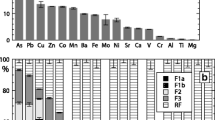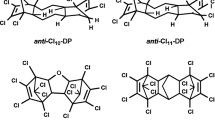Abstract
Background, Aim and Scope
With the predicted climate change, it is expected that the chances of flooding may increase. During flood events, sediments will resuspend and when the sediments are polluted, contaminants can be transferred to the surrounding water. Mass transfer of organic compounds like Persistent Organic Pollutants (POPs) from soils and sediments to the surrounding aqueous phase are essential regarding fate and transport of these chemicals in the aqueous environment. The distribution of POPs between sorbed and aqueous phases and the time needed to obtain equilibrium are required to calculate the exposure to potential receptors. A reactor was designed in which the water flow is controlled and low POP concentrations could be measured by tenax extraction outside the reactor vessel. This reactor design named SPEED (Solid Phase Extraction with External Desorption) was used to study desorption from aged contaminated sediment in relation to sediment particle size.
Materials and Methods
In the newly developed SPEED (Solid Phase Extraction with External Desorption) reactor, the water flow rate was set and controlled, and low aqueous POP concentrations were measured by sorption to Tenax® outside the reaction vessel. The effect of particle size on desorption rate was studied using a widely used Tenax® solid phase extraction method.
Results
The experiments, by specific measurement of the aqueous dieldrin concentration at different HRT, show that desorption of dieldrin in time is faster when short HRTs were applied. However, the mass of dieldrin desorbed per liter refreshed water is higher for longer HRTs. Therefore, the mass transfer of dieldrin within the sediment particles is the rate determining process in contaminant desorption. This observation was confirmed by Tenax® solid phase extractions which were applied for different particle size fractions. Desorption rates of POPs from the sediment fraction with small particles were faster than desorption rates from the sediment fraction with large particles. Organic matter was present as separate particles in the sediment sample. All experiments demonstrated biphasic desorption. The fluxes calculated for both phases are supportive of non-stationary diffusion as the main process of mass transfer.
Discussion
In the literature, the relation between particle size and desorption of organic contaminants from soils and sediments is contradictory. Most often this seems to be due to overlooking the spatial configuration of organic matter in the soils and sediments. In several papers the presence of organic matter as a thin coating around mineral particles has been overlooked. There-fore, milling had no effect on desorption behavior of contaminants, as the diffusion length will not be affected. In our opinion, both the particle size and spatial configuration of organic matter are rate determining parameters of the desorption process.
Conclusions
Flood events will result in an increase of desorption rate of POPs from sediments to the surrounding water. HRT and particle size determine the concentration gradient and, thereby, the desorption rate. Furthermore, the diffusion length will be smaller when sediment particles are suspended and more water is present to decrease the aqueous concentration. We conclude that non-stationary diffusion within organic matter is the main process of mass transfer. The combination of simulated in-situ measurements of desorption from sediments with generic measurable parameters like flow rate and particle size distribution results in a quantitative measurable flux of contaminants, which resembles the in-situ (bio)availability as the result of dynamic processes in the sediment/water system.
Recommendations and Perspectives
The results obtained provided a sound basis for mechanistic modeling of POP mass transfer from sediment to water. The modeling results will be presented in a separate paper. Besides the HRT, also mixing conditions can be changed to assess the desorption from sediment layers. The possibility to combine flow rate and mixing intensity enables the study of the effect of hydraulically different river systems on desorption of contaminants. In a long term perspective we foresee a link with hydrology and sediment transport with desorption in water bodies.
Similar content being viewed by others
References
Owens P (2005): Conceptual models and budgets for sediment management at the river basin scale. J Soils Sediments 5, 201–212
Foerstner U (2005): BMBF coordinated research project SEDYMO (2002–2006)-Sediment dynamics and pollutant mobility in river basins. J Soils Sediments 5, 134–138
Rulkens WH, Bruning H, Cuypers C, Grotenhuis JTC (2004): Modeling bioavailability of PAH in soil. In: Twardowska I (ed), Solid Waste: Assessment, Monitoring and Remediation. Waste Management Series. Elsevier, Amsterdam, pp 633–649
Sabbah I, Ball WP, Young DF, Bouwer EJ (2005): Misinterpretations in the modeling of contaminant desorption from environmental solids when equilibrium conditions are not fully understood. Environ Eng Sci 22, 350–366
Lambert SM (1967): Functional relationship between sorption in soil and chemical structure. J Agric Food Chem 15, 572
Chiou CT, Peters LJ, Freed VH (1979): Physical concept of soil-water equilibria for non-ionic organic-compounds. Science 206, 831–832
Karickhoff SW, Brown DS, Scott TA (1979): Sorption of hydrophobic pollutants on natural sediments. Water Res 13, 241–248
Briggs GG (1981): Theoretical and experimental relationships between soil adsorption, octanol-water partition-coefficients, water solubilities, bioconcentration factors, and the parachor. J Agric Food Chem 29, 1050–1059
Ditoro DM, Horzempa LM (1982): Reversible and resistant components of PCB adsorption desorption — Isotherms. Environ Sci Technol 16, 594–602
Accardi-Dey A, Gschwend PM (2003): Reinterpreting literature sorption data considering both absorption into organic carbon and adsorption onto black carbon. Environ Sci Technol 37, 99–106
Xia GS, Pignatello JJ (2001): Detailed sorption isotherms of polar and apolar compounds in a high-organic soil. Environ Sci Technol 35, 84–94
Allen-King RM (2002): New modeling paradigms for the sorption of hydrophobic organic chemicals to heterogeneous carbonaceous matter in soils, sediments, and rocks. Advances in Water Resources 25, 985–1016
Kan AT, Fu G, Hunter M, Chen W, Ward CH, Tomson MB (1998): Irreversible sorption of neutral hydrocarbons to sediments: Experimental observations and model predictions. Environ Sci Technol 32, 892–902
Hinz C (2001): Description of sorption data with isotherm equations. Geoderma 99, 225–243
Koelmans AA, Jonker MTO, Cornelissen G, Bucheli TD, Van Noort PCM, Gustafsson O (2006): Black carbon: The reverse of its dark side. Chemosphere 63, 365–377
Saffron CM, Park JH, Dale BE, Voice TC (2006): Kinetics of contaminant desorption from soil: Comparison of model formulations using the Akaike information criterion. Environ Sci Technol 40, 7662–7667
Schwab K (2007): Large volume TENAX (R) extraction of the bioaccessible fraction of sediment-associated organic compounds for a subsequent effect-directed analysis. J Soils Sediments 7, 178–186
Rahman M, Amiri F, Worch E (2003): Application of the mass transfer model for describing non-equilibrium transport of HOCs through natural geosorbents. Water Res 37, 4673–4684
Wu SC, Gschwend PM (1986): Sorption kinetics of hydrophobic organic-compounds to natural sediments and soils. Environ Sci Technol 20, 717–725
Kleineidam S, Rugner H, Grathwohl P (1999): Impact of grain scale heterogeneity on slow sorption kinetics. Environ Toxicol Chem 18, 1673–1678
Van Beinum W, Beulke S, Brown CD (2006): Pesticide sorption and desorption by lignin described by an intraparticle diffusion model. Environ Sci Technol 40, 494–500
Gamst J, Moldrup P, Rolston DE, Scow KM, Henriksen K, Komatsu T (2004): Time-dependency of naphthalene sorption in soil: Simple rate-, diffusion-, and isotherm-parameter-based models. Soil Sci 169, 342–354
Werth CJ, Reinhard M (1997): Effects of temperature on trichloroethylene desorption from silica gel and natural sediments.1. Isotherms. Environ Sci Technol 31, 689–696
Johnson MD, Keinath TM, Weber WJ (2001): A distributed reactivity model for sorption by sails and sediments. 14. Characterization and modeling of phenanthrene desorption rates. Environ Sci Technol 35, 1688–1695
Lin TF, Little JC, Nazaroff WW (1994): Transport and sorption of volatile organic-compounds and water-vapor within dry soil grains. Environ Sci Technol 28, 322–330
Rugner H, Kleineidam S, Grathwohl P (1999): Long term sorption kinetics of phenanthrene in aquifer materials. Environ Sci Technol 33, 1645–1651
Li J, Werth CJ (2004): Slow desorption mechanisms of volatile organic chemical mixtures in soil and sediment micropores. Environ Sci Technol 38, 440–448
Buurman PP (1997): Laser grain-size determination in soil genetic studies. 1. Practical problems. Soil Sci 162, 211–218
Cornelissen G, vanNoort PCM, Govers HAJ (1997): Desorption kinetics of chlorobenzenes, polycyclic aromatic hydrocarbons, and polychlorinated biphenyls: Sediment extraction with Tenax(R) and effects of contact time and solute hydrophobicity. Environ Toxicol Chem 16, 1351–1357
Yeom IT, Ghosh MM, Cox CD, Ahn KH (1996): Dissolution of polycyclic aromatic hydrocarbons from weathered contaminated soil. Water Sci Technol 34, 335–342
Carroll KM, Harkness MR, Bracco AA, Balcarcel RR (1994): Application of a permeant polymer diffusional model to the desorption of polychlorinated-biphenyls from Hudson River sediments. Environ Sci Technol 28, 253–258
Crank J (1975): The mathematics of diffusion. Clarendon, Oxford, 414 pp
Author information
Authors and Affiliations
Corresponding author
Rights and permissions
About this article
Cite this article
Smit, M.P.J., Grotenhuis, T., Bruning, H. et al. Desorption of Dieldrin from field aged sediments: Simulating flood events. J Soils Sediments 8, 80–85 (2008). https://doi.org/10.1065/jss2008.03.280
Received:
Accepted:
Published:
Issue Date:
DOI: https://doi.org/10.1065/jss2008.03.280




